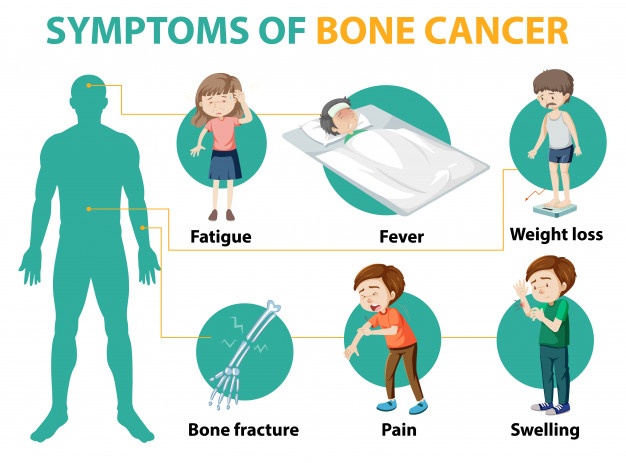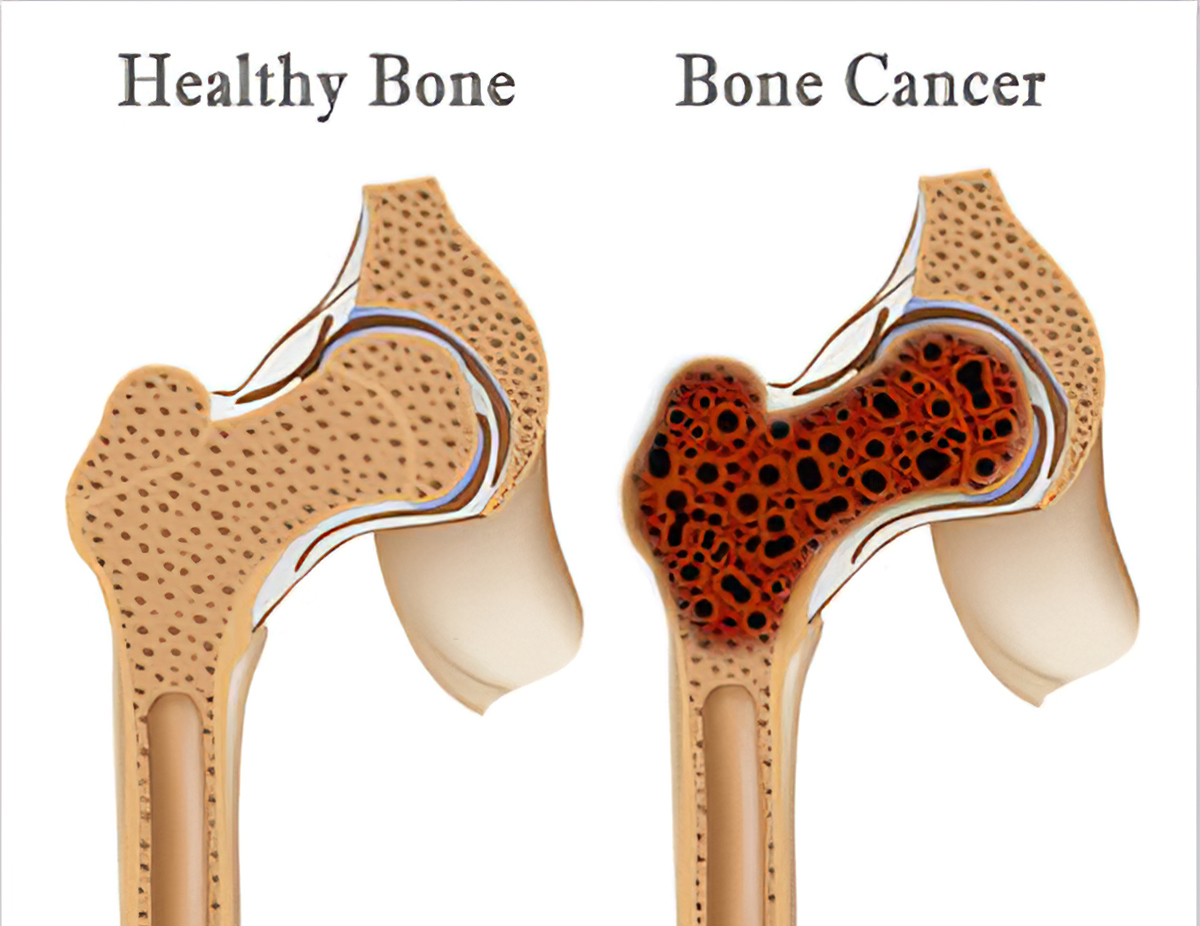Bone cancer is usually rare. It is an unusual growth of cells out of control in your bone destroying the normal bone tissue. Bone cancer could be metastasizing from other organs or tumors of the bone. Bone acts as a supporting framework of the body.
Most bone tumors are benign, meaning they are not cancerous and don’t spread to other areas of the body. However, they may weaken the bones as well as lead to broken bones or other medical problems.
The tumor could be malignant, referred to as cancerous, and they grow aggressively and spread to other parts of the body. Usually the treatment for bone cancer is surgery, early diagnosis and management helps in recovering at an early stage.

TYPES OF BONE CANCER
Tumors could be benign or malignant in nature. Malignant tumors are cancerous in nature. Bone cancer is categorized as primary and secondary in nature depending on their origin. Primary type of bone cancer is the most serious because they are formed in the bones or the surrounding tissue like cartilage.
Secondary bone cancer spreads or metastasizes from another part of the body to the bones. Primary cancer is usually rare. Some common types of primary bone cancer are;
- Multiple Myeloma – It is caused by outgrowth of cancer cells in the bone marrow and causes tumors in various bones. It usually affects older adults.
- Osteosarcoma (Osteogenic sarcoma) – Children and adolescents are prone to this type of cancer. It originates at the end of the long bones present in the arms and legs. It may begin in the bones of hips, shoulders, or other locations affecting the hard tissues that makeup the outer layer of your bones.
- Chondrosarcoma – This type of bone cancer occurs in the cartilage of bones of pelvis, thigh areas, and shoulders. The cartilage forms the sub-chondral tissue that is the tough connective tissue between the bones. It is the second most common primary affecting mainly the older adults. It usually develops slowly over a long time.
- Ewing’s sarcoma – this is a rare type of cancer. This begins in the soft tissues that surround the bones or sometimes directly in the bones itself. The long bones like the bones of arms and legs or pelvis bones are commonly affected.
Bone cancer occurs in 4 stages and these stages are scored on the size of tumor, if cancer is located in the lymph node or if it has a different origin than bone itself.
Complications, which depend on the organs involved, could include:
Stage I – This is considered low-grade as the cancer cells are localized to the bone. The size of the tumor ranges from 8cm to above found in different places of bone.
Stage II – This is considered as high-grade and the cancer cells are still localized to the bone. The tumor can be larger than 8cm.
Stage III – The primary bone cancer is high-grade and has spread to several parts of the same bone. It is considered high-grade.
Stage IV – This is the most advanced stage and the cancer cells have spread beyond the bone to other parts of the body. The tumor could be of any size and might have spread to the lymph node. Doctors also take into account the degree of abnormality of the cells under microscope at this stage. This stage is classified as a metastatic stage.

BONE CANCER SYMPTOMS AND DIAGNOSIS :-
The exact cause of the bone cancer is not known. However, the below factors contribute or increase the chance of developing abnormal growth in the bone.
Abnormal Cell Growth – The healthy cells divide and replace the old cells and die after the process is complete. But the abnormal cells continue to live even after cell division. This creates mass of tissue turning into tumors.
Radiation Therapy – This therapy is used for treatment of cancer, but using high doses of radiation may be a factor in developing cancer cells.
BONE CANCER SYMPTOMS AND DIAGNOSIS :-
Pain in and around the affected bone is the first symptom of bone cancer. Pain would initially develop at definite times of the day, usually at night, or during physical activity. The pain is likely to progress and worsen with time. The pain could be dull and achy. The pain sometimes may be present for years before you seek treatment. The other symptoms include:
- Numbness, tingling or, tenderness near the affected bone
- Decreased blood flow beyond the site of tumor
- Weak or absence of pulse
- Cold hand and feet
- Fracture due to weakened bone
- Fatigue
- Sudden weight loss
- Fever
- Sweating at night
- Limping due to amputation
The doctor would diagnose the bone cancer based on above symptoms and family history. They would also recommend imaging tests like X-Ray, CT scan, MRI scan, PET scan or bone scan. These tests would check for abnormality of cells as well as extent of cancer. Biopsy would confirm the evaluation done by these imaging tests. Biopsy also determines if the tumor is benign, primary or secondary cancer.

BONE CANCER TREATMENT
The treatment regime of bone cancer depends on the stage of cancer, patient’s age, patient’s overall health or the size and location of the tumor. Doctor would follow below treatment to remove cancer cells and reduce the symptoms:
- Surgery – It aims to remove the tumor in a single piece and small portion of the healthy bone tissue surrounding the bone. The surgeon would replace the lost bone with bone from another area or with a replacement made of metal and hard plastic. As other treatments are more effective the amputation or surgery is becoming less common.
- Chemotherapy – This treatment uses strong anti-cancer drugs administered intravenously (through a vein) to kill cancer cells. This treatment is used before surgery, after surgery or for metastatic cancer.
- Radiation Therapy – This treatment uses high-powered beams of energy like X-rays, to kill cancer cells. The high-powered rays could shrink the tumor and make it easier to remove instead of amputation. Radiation therapy also helps in controlling the signs and symptoms like pain in people suffering from an advanced stage. It is a standard procedure for treatment of Ewing sarcoma and a part of combination treatment for other bone cancers.
- Targeted therapy – These drug treatment targets specific genetic, proteins, or other changes in as well as around cancer cells. Most commonly used drug is imatinib (Gleevec) by blocking the signals from mutated genes responsible for causing tumors.
- Cryosurgery – This treatment technique replaces the need for surgery to remove tumors from bone tissue. A treatment targets cancer cells with liquid nitrogen to freeze and destroy the cancer cells.These treatments target the cancer cells however; they might also destroy some of the healthy cells in the process.
A cancer diagnosis could be overwhelming. With time and help of family and close relatives you’ll find ways to cope with the distress and uncertainty of cancer. Cancerous tumors require stronger treatment and care.
If you or anyone you know is suffering from bone cancer, our expert providers at Specialty Care Clinics will take care of your health and help you recover.
Call us on 469-545-9983 to book an appointment with Dr.Raymond Fulp .
